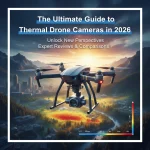[Get the best value drone with thermal camera on Amazon today!]
# The Ultimate Guide to Drone with Thermal Camera Technology
Drones have revolutionized industries ranging from agriculture to search and rescue, and the integration of thermal camera technology has taken their capabilities to a whole new level. If you’re looking to understand the power and potential of a drone with a thermal camera, you’ve come to the right place. This guide will explore everything you need to know, from the basics of thermal imaging to the specific applications and benefits these advanced drones offer.
[Browse top-rated drone with thermal camera on Amazon]
## Understanding Thermal Imaging Technology
Before diving into the specifics of drones with thermal cameras, it’s essential to grasp the fundamentals of thermal imaging. Unlike traditional cameras that capture visible light, thermal cameras detect infrared radiation emitted by objects. This radiation is directly related to an object’s temperature, allowing the camera to create a visual representation of heat distribution. This is also sometimes referred to as thermography.
Thermal imaging is useful because it can “see” heat signatures, even in complete darkness or through obstructions like smoke or fog. The resulting images, often displayed in color gradients, reveal temperature differences that would be invisible to the naked eye. This makes thermal cameras incredibly valuable in a wide range of applications.
[Browse top-rated drone with thermal camera on Amazon]
## Applications of Drones with Thermal Cameras
The combination of drone technology and thermal imaging opens up a vast array of possibilities. Here are some of the most common and impactful applications:
* **Search and Rescue:** Thermal drones can quickly scan large areas to locate missing persons, even in challenging terrain or low-light conditions. The ability to detect body heat signatures dramatically increases the chances of a successful rescue.
* **Building Inspection:** Identifying insulation leaks, moisture intrusion, and electrical hotspots in buildings is made easy with thermal drones. This allows for proactive maintenance and prevents costly repairs.
* **Agriculture:** Farmers can use thermal drones to monitor crop health, detect irrigation issues, and identify areas affected by pests or diseases. This enables targeted interventions and optimizes resource allocation.
* **Law Enforcement:** Thermal drones provide law enforcement agencies with a powerful tool for surveillance, suspect apprehension, and crime scene investigation.
* **Firefighting:** Firefighters can use thermal drones to assess the extent of a fire, identify hotspots, and locate trapped individuals. This improves situational awareness and enhances safety.
* **Industrial Inspection:** Inspecting power lines, pipelines, and other industrial infrastructure for defects or leaks is made safer and more efficient with thermal drones.
* **Wildlife Monitoring:** Researchers can use thermal drones to study animal populations, track their movements, and monitor their health without disturbing their natural habitat.
* **Security:** Thermal drones can be deployed for perimeter security, detecting intruders or unauthorized activity even in complete darkness.
[Browse top-rated drone with thermal camera on Amazon]
## Key Features to Look for in a Drone with Thermal Camera
Choosing the right drone with a thermal camera can be a daunting task, given the variety of models and features available. Here are some key factors to consider:
* **Thermal Camera Resolution:** Higher resolution thermal cameras produce sharper and more detailed images, allowing for more accurate temperature measurements and analysis. Look for a resolution of at least 640×512 for professional applications.
* **Thermal Sensitivity (NETD):** Noise Equivalent Temperature Difference (NETD) measures the camera’s ability to detect subtle temperature differences. A lower NETD value indicates higher sensitivity. Aim for an NETD of 50 mK or lower.
* **Frame Rate:** A higher frame rate results in smoother and more fluid thermal video, which is particularly important for applications involving moving objects. Look for a frame rate of at least 30 Hz.
* **Lens Options:** Different lenses offer different fields of view and magnification levels. Consider the specific applications you have in mind when choosing a lens.
* **Drone Flight Time:** Longer flight times allow for more extensive data collection and reduce the need for frequent battery changes. Look for a drone with a flight time of at least 30 minutes.
* **Drone Stability and Maneuverability:** A stable and maneuverable drone is essential for capturing clear and accurate thermal images, especially in windy conditions.
* **Software and Data Analysis Tools:** User-friendly software and data analysis tools are crucial for processing and interpreting thermal data. Look for features such as temperature measurement, image enhancement, and report generation.
* **GPS and Mapping Capabilities:** GPS and mapping capabilities allow for accurate geo-referencing of thermal data, which is essential for creating orthomosaics and 3D models.
* **Payload Capacity:** If you plan to add additional sensors or equipment to the drone, make sure it has sufficient payload capacity.
* **Regulatory Compliance:** Ensure that the drone complies with all applicable regulations and licensing requirements in your region.
[Browse top-rated drone with thermal camera on Amazon]
## Recommended Drones with Thermal Camera Technology
Here are a few of the top drones with thermal camera technology that offer a balance of performance, features, and price:
### 1. DJI Mavic 3 Thermal
**Best For:** Versatile professional use, combining high-resolution thermal and visual cameras.
**Key Features:**
* Dual cameras: 640×512 thermal and 48MP visual camera.
* Up to 45 minutes of flight time.
* Omnidirectional obstacle sensing.
* Zoom capabilities in both thermal and visual modes.
**Why We Like It:** The DJI Mavic 3 Thermal is a powerhouse for various applications. Its high-resolution thermal camera captures detailed temperature data, while the visual camera provides excellent situational awareness. The long flight time and advanced obstacle sensing make it a reliable and safe choice.
### 2. Autel EVO Max 4T
**Best For:** Advanced imaging and autonomous flight capabilities.
**Key Features:**
* Tri-camera system: thermal, wide-angle, and zoom cameras.
* Autonomous flight modes for mapping and inspection.
* Advanced obstacle avoidance and subject tracking.
* IP43 weather resistance.
**Why We Like It:** The Autel EVO Max 4T stands out with its tri-camera system, offering unparalleled versatility. Its autonomous flight modes and advanced obstacle avoidance make it ideal for complex missions. The weather resistance adds to its durability and reliability.
### 3. FLIR SIRAS
**Best For:** Industrial inspections and applications requiring precise temperature measurements.
**Key Features:**
* High-resolution FLIR Boson thermal camera.
* Multiple lens options for different applications.
* SDK for custom software development.
* Designed for rugged environments.
**Why We Like It:** The FLIR SIRAS is built for demanding industrial applications. Its high-resolution FLIR Boson thermal camera delivers accurate temperature measurements, while the multiple lens options provide flexibility. The SDK allows for custom software development to meet specific needs.
[Browse top-rated drone with thermal camera on Amazon]
## Safety Considerations When Using Thermal Drones
Operating drones with thermal cameras requires adherence to safety protocols and regulations. Here are some important considerations:
* **Regulatory Compliance:** Familiarize yourself with and comply with all applicable regulations and licensing requirements in your region. This may include obtaining a drone pilot license and registering your drone with the relevant authorities.
* **Flight Planning:** Plan your flights carefully, taking into account weather conditions, airspace restrictions, and potential hazards.
* **Pre-Flight Checks:** Perform thorough pre-flight checks to ensure that the drone, thermal camera, and all other equipment are in good working order.
* **Visual Line of Sight (VLOS):** Maintain visual line of sight with the drone at all times, unless operating under specific waivers or exemptions.
* **Obstacle Avoidance:** Utilize the drone’s obstacle avoidance system to avoid collisions with buildings, trees, and other objects.
* **Privacy Considerations:** Be mindful of privacy concerns when operating thermal drones, especially in residential areas. Avoid capturing images or videos of individuals without their consent.
* **Data Security:** Protect the thermal data you collect from unauthorized access or disclosure. Implement appropriate security measures to safeguard sensitive information.
* **Battery Management:** Properly manage drone batteries to ensure safe and reliable operation. Avoid overcharging or discharging batteries, and store them in a cool, dry place.
* **Emergency Procedures:** Develop and practice emergency procedures for dealing with unexpected situations, such as drone malfunctions or loss of signal.
[Browse top-rated drone with thermal camera on Amazon]
## Pro-Tips for Optimizing Thermal Drone Performance
Here are some pro-tips to help you get the most out of your drone with thermal camera:
* **Calibrate the Thermal Camera Regularly:** Calibrating the thermal camera ensures accurate temperature measurements. Follow the manufacturer’s instructions for calibration procedures.
* **Use the Correct Emissivity Settings:** Emissivity is a measure of an object’s ability to emit infrared radiation. Using the correct emissivity settings for different materials is crucial for accurate temperature readings.
* **Fly at the Optimal Altitude:** Flying at the optimal altitude allows you to capture the best thermal images while minimizing the risk of collisions.
* **Adjust the Color Palette:** Experiment with different color palettes to find the one that best highlights the temperature differences you are interested in.
* **Use Image Enhancement Techniques:** Utilize image enhancement techniques, such as contrast stretching and noise reduction, to improve the clarity and detail of thermal images.
* **Combine Thermal and Visual Data:** Combining thermal and visual data can provide a more comprehensive understanding of the scene.
* **Use Ground Control Points (GCPs):** Use GCPs to improve the accuracy of orthomosaics and 3D models created from thermal drone data.
* **Stay Up-to-Date on the Latest Technology:** The field of thermal drone technology is constantly evolving. Stay up-to-date on the latest advancements to maximize the benefits of your investment.
[Browse top-rated drone with thermal camera on Amazon]
## FAQ Section
**Q: What is the difference between thermal imaging and night vision?**
A:
[Check the latest prices and deals for drone with thermal camera on Amazon today!]











